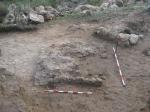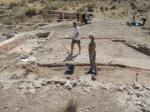Summary (English)
Poblado de Coimbra is one of the two major population centres of the Jumilla-Yecla plateau, in conjunction with the habitat around Cerro del Castillo (Jumilla). El Poblado is located in the first third of the north and southwest slopes of the Cerro del Maestre. Its strategic position allows it to control the natural route connecting with the Segura valley and continuing onto La Mancha, passing through the Cerro de los Santos.
The first mentions to this site go back to the 17th century. In 1955 J. Molina García started the first excavation and, facing the spectacular discoveries, a new archaeological campaign was carried out the following year. The works were interrupted for two decades and in 1977 A. M. Muñoz Amilibia resumes the systematic excavation of the Iberian settlement. The first interventions were focused on the eastern part of the habitat where several houses and a defensive system were found. Since the 1980s and 1990s the focus is on the Necropolis of El Poblado where 146 burials were already found in 2001.
The settlement of El Poblado has a spectacular defensive system. The walls surround a zone of 54 hectares and has two entrances. Its urban planning, with houses constructed in terraces and streets determining rectangular blocks, is interesting. In this way, the general plan is organised as a draughtboard adapted to the terrain. The pavements of houses and streets are made of rammed earth and only occasionally is stone used. As is usual in Iberian settlements, the houses are built on a stone socleand the walls erected with red adobes jointed with yellow clay.
In the same eastern part of the same plain is located the Necropolis of El Poblado. It is 130 meters long and 35 meters wide. Following the first campaigns carried out by J. Molina between 1956 and 1960, the archaeological interventions continued from 1980 to 1986. A new cycle of systematic excavations started in 1998 and has continued to the present. Burials are cremations in pit with similar grave goods. From the 3rd century BC the number of funerary urns is remarkably increased.
(translation by Pilar Alarcón Blázquez)
- Rafael González Fernández
Director
- José Miguel García Cano (Universidad de Murcia)
Team
- Emiliano Hernández Carrión (Director del Museo Arqueológico de Jumilla); Rosa María Gualda Bernal; Juan Gallardo Carrillo; Francisco Ramos Martínez; José Javier Martínez García; Celso Miguel Sánchez Mondéjar
- José Miguel García Cano (Universidad de Murcia)
Research Body
- Universidad de Murcia, Centro de Estudios del Próximo Oriente y la Antigüedad Tardía (CEPOAT)
Funding Body
- Ayuntamiento de Jumilla
- Universidad de Murcia






![Download [PDF]](/excavation/skins/fasti/images/results/download_sml.png)

